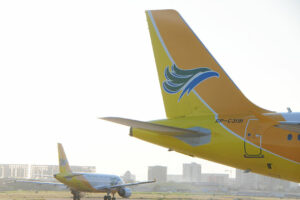BUDGET CARRIER Cebu Pacific is allocating P50 billion for its capital expenditure (capex) in 2024 mainly for its aircraft-related expenses, the company’s top official said.
“We estimate around P50 billion in 2024. It is mostly aircraft-related capex,” Alexander G. Lao, president and chief commercial officer of Cebu Pacific, told reporters last week.
The company targets to grow its fleet with an anticipated 16 new aircraft by 2024, Mr. Lao said, adding that the company is targeting to grow the number to 92 from the current 76.
Earlier this year, Cebu Pacific announced that it was expecting its biggest aircraft purchase to be completed by early next year.
To recall, the company is planning to order more than 100 narrow-body aircraft from Boeing or Airbus valued at an estimated $12 billion.
“The RFP (request for proposal) is still ongoing. It will be an exciting few weeks and a lot of the OEMs (original equipment manufacturers) are coming in to make their pitch and presentations,” he said, noting that the company hopes to process it by the first quarter of 2024.
In September, the company’s listed operator Cebu Air, Inc. said it would lower its fleet growth rate for 2024 as engine maker Pratt and Whitney (P&W) inspects A320/321 NEO aircraft engines worldwide following suspected issues.
“What we have said publicly is that we expect anywhere between 10 and 20 aircraft to be parked because of Pratt & Whitney throughout the year,” Mr. Lao said.
To mitigate this, the company will be doing short-term leases such as the agreement it entered with Bulgaria Air.
Last week, Cebu Pacific said it had signed a damp lease agreement with Bulgaria Air amid anticipation of increased passenger demand.
Further, despite an expectation of passenger upward demand, Cebu Pacific said that it does not expect to hit its pre-pandemic passenger count of 22 million this year.
“I think we will be slightly below that given all of the Pratt & Whitney-related issues. [It was] mentioned that by year-end, we will be at 103% of pre-COVID capacity on a systemwide basis but from a passenger point of view, I don’t think we will hit the 2019 numbers just yet,” Mr. Lao said.
The Gokongwei-led company, however, has expressed optimism about reaching the pre-pandemic passenger count next year by growing its seats by roughly between 5% and 8%.
“Clearly, for next year, that is what we’re going to aim to do. [For 2023,] we will be close enough to our 2019 passenger number, pretty close to that,” Mr. Lao said. — Ashley Erika O. Jose
